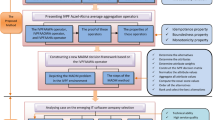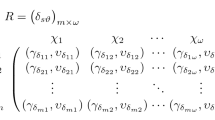Abstract
The motivation of this paper is to build up a new technique to manage multi-attribute decision-making (MADM) issues with interval-valued Pythagorean fuzzy (IVPF) set according to the concepts of Hamacher t-norm and t-conorm, and give its application in MADM problems. To begin with, we integrate the Hamacher operations on IVPF sets. Then, in view of these operations, we formulate a few IVPF aggregation operators, for example, IVPF Hamacher weighted average operator, IVPF Hamacher order weighted average operator, IVPF Hamacher hybrid average operator, IVPF Hamacher weighted geometric operator, IVPF Hamacher order weighted geometric operator, and IVPF Hamacher hybrid geometric operator. We investigate the distinguished features of these suggested operators. Moreover, we carry out the proposed aggregation operators to produce a method for solving MADM issues under IVPF data. We present an example of the emerging software system selection to elaborate on its practicality and effectiveness. We investigate the impact of the parameter for different values on decision-making outcomes. The main advantage of utilizing the suggested operator lies in the fact that this operator provides an increasingly complete perspective on the issue to the decision-makers. The technique suggested in this study gives progressively broad, improve the accuracy and exact outcomes when contrasted with the existing related methods. Therefore, this technique performs an important function in real-life MADM issues.

Similar content being viewed by others
References
Attanassov KT (1986) Intuitionistic fuzzy sets. Fuzzy Sets Syst 20:87–96
Chen TY (2018) An interval-valued Pythagorean fuzzy outranking method with a closeness-based assignment model for multiple criteria decision making. Int J Intell Syst 33(1):126–168
Chen ZS, Chin KS, Li YL, Yang Y (2016) Proportional hesitant fuzzy linguistic term set for multiple criteria group decision making. Inf Sci 357:61–87
Chen ZS, Yang Y, Wang XJ, Chin KS, Tsui KL (2019) Fostering linguistic decision-making under uncertainty: A proportional interval type-2 hesitant fuzzy TOPSIS approach based on Hamacher aggregation operators and andness optimization models. Inf Sci 500:229–258
Chen ZS, Liu XL, Rodríguez RM, Wang XJ, Chin KS, Tsui KL, Martínez L (2020) Identifying and prioritizing factors affecting in-cabin passenger comfort on high-speed rail in China: a fuzzy-based linguistic approach. Appl Soft Comput 95
Chen ZS, Liu XL, Chin KS, Pedrycz W, Tsui KL, Skibniewski MJ (2021) Online-review analysis based large-scale group decision-making for determining passenger demands and evaluating passenger satisfaction: Case study of high-speed rail system in China. Inf Fus 69:22–39
Deschrijver G, Cornelis C, Kerre EE (2004) On the representation of intuitionistic fuzzy t-norms and t-conorms. IEEE T Fuzzy Syst 12:45–61
Dey A, Senapati T, Pal M, Chen G (2020) A novel approach to hesitant multi-fuzzy soft set based decision-making. AIMS Math 5(3):1985–2008
Du Y, Hou F, Zafar W, Yu Q, Zhai Y (2017) A novel method for multiattribute decision making with interval-valued Pythagorean fuzzy linguistic information. Int J Intell Syst 32(10):1085–1112
Garg H (2016) A novel accuracy function under interval-valued Pythagorean fuzzy environment for solving multi-criteria decision making problem. J Intell Fuzzy Syst 31(1):529–540
Garg H (2017) A new improved score function of an interval-valued Pythagorean fuzzy set based TOPSIS method. Int J Uncertain Quant 7(5):463–474
Hamachar H (1978) Uber logische verknunpfungenn unssharfer Aussagen und deren Zugenhorige Bewertungsfunktione Trappl, Progress in Cybernatics and Systems Research, K. Riccardi, eds 3:276–288
Huang YH, Wei GW (2018) TODIM method for interval-valued Pythagorean fuzzy multiple attribute decision making. Int J Knowl Based Intell Eng Syst 22:249–259
Jana C, Pal M (2018) Assessment of enterprise performance based on picture fuzzy Hamacher aggregation operators. Symmetry 11(1):75. https://doi.org/10.3390/sym11010075
Jana C, Senapati T, Pal M, Yager RR (2019) Picture fuzzy Dombi aggregation operators: application to MADM process. Appl Soft Comput 74:99–109
Jana C, Senapati T, Pal M (2019) Pythagorean fuzzy Dombi aggregation operators and its applications in multiple attribute decision-making. Int J Intell Syst 34(9):2019–2038
Jana C, Muhiuddin G, Pal M (2020) Multiple-attribute decision making problems based on SVTNH methods. J Ambient Intell Hum Comput 11:3717–3733
Li Z, Wei G, Gao H (2018) Methods for multiple attribute decision making with interval-valued Pythagorean fuzzy information. Mathematics 6:228. https://doi.org/10.3390/math6110228
Li Z, Wei G, Lu M (2018) Pythagorean fuzzy hamy mean operators in multiple attribute group decision making and their application to supplier selection. Symmetry-Basel 10(10):505
Liang D, Darko AP, Xu Z (2018) Interval-valued Pythagorean fuzzy extended Bonferroni mean for dealing with heterogenous relationship among attributes. Int J Intell Syst 33(7):1381–1411
Liu P (2014) Some hamacher aggregation operators based on the interval-valued intuitionistic fuzzy numbers and their application to group decision making. IEEE Trans Fuzzy Syst 22(1):83–97
Lu M, Wei G, Alsaadi FE, Hayat T, Alsaedi A (2017) Hesitant Pythagorean fuzzy Hamacher aggregation operators and their application to multiple attribute decision making. J Intell Fuzzy Syst 33(2):1105–1117
Lu J, He T, Wei G, Wu J, Wei C (2020) Cumulative prospect theory: performance evaluation of Government purchases of home-based elderly-care services using the Pythagorean 2-tuple linguistic TODIM method. Int J Environ Res Public Health 17(6):1939
Peng X, Yang Y (2016) Fundamental properties of interval-valued Pythagorean fuzzy aggregation operators. Int J Intell Syst 31(5):444–487
Rahman K, Abdullah S (2019) Some induced generalized interval-valued Pythagorean fuzzy Einstein geometric aggregation operators and their application to group decision-making. Comput Appl Math 38(3):139
Rahman K, Abdullahb S (2019) Some new generalized interval-valued Pythagorean fuzzy aggregation operators using Einstein \(t\)-norm and \(t\)-conorm. J Intell Fuzzy Syst 37(3):3721–3742
Rahman K, Abdullah S, Shakeel M, Sajjad Ali Khan M, Ullah M (2017) Interval-valued Pythagorean fuzzy geometric aggregation operators and their application to group decision making problem. Cogent Math 4:1338638
Rahman K, Ali A, Abdullah S, Amin F (2018) Approaches to multi-attribute group decision making based on induced interval-valued Pythagorean fuzzy Einstein aggregation operator. New Math Nat Comput 14(3):343–361
Rahman K, Abdullah S, Ali A, Amin F (2019) Interval-valued Pythagorean fuzzy Einstein hybrid weighted averaging aggregation operator and their application to group decisionmaking. Complex Intell Syst 5:41–52
Roychowdhury S, Wang BH (1998) On generalized Hamacher families of triangular operators. Int J Approx Reason 19:419–439
Sajjad Ali Khan M, Abdullah S, Ali MY, Hussain I, Farooq M (2018) Extension of TOPSIS method base on Choquet integral under interval-valued Pythagorean fuzzy environment. J Intell Fuzzy Syst 34(1):267–282
Senapati T, Yager RR (2019) Some new operations over Fermatean fuzzy numbers and application of Fermatean fuzzy WPM in multiple criteria decision making. Informatica 30(2):391–412
Senapati T, Yager RR (2019) Fermatean fuzzy weighted averaging/geometric operators and its application in multi-criteria decision-making methods. Eng Appl Artif Intell 85:112–121
Senapati T, Yager RR (2020) Fermatean fuzzy sets. J Ambient Intell Human Comput 11(2):663–674
Senapati T, Yager RR, Chen G (2020) Cubic intuitionistic WASPAS technique and its application in multi-criteria decision-making. J Ambient Intell Human Comput. https://doi.org/10.1007/s12652-020-02667-8
Tan C, Yi W, Chen X (2015) Hesitant fuzzy Hamacher aggregation operators for multicriteria decision making. Appl Soft Comput 26:325–349
Tang XY, Wei GW, Gao H (2019) Models for multiple attribute decision making with interval-valued pythagorean fuzzy Muirhead mean operators and their application to green suppliers selection. Informatica 30(1):153–186
Wang TC, Lee HD (2009) Developing a fuzzy TOPSIS approach based on subjective weights and objective weights. Expert Syst Appl 36:8980–8985
Wei G, Lu M, Tang X, Wei Y (2018) Pythagorean hesitant fuzzy Hamacher aggregation operators and their application to multiple attribute decision making. Int J Intell Syst 33(6):1197–1233
Wei G, Garg H, Gao H, Wei C (2018) Interval-valued pythagorean fuzzy Maclaurin symmetric mean operators in multiple attribute decision making. IEEE Access 6:67866–67884
Wei G, Tang Y, Zhao M, Lin R, Wu J (2020) Selecting the low-carbon tourism destination: based on Pythagorean fuzzy taxonomy method. Mathematics 8(5):832
Yager RR (2014) Pythagorean membership grades in multicriteria decision making. IEEE Trans Fuzzy Syst 22:958–965
Yager RR, Abbasov AM (2013) Pythagorean membership grades, complex numbers and decision making. Int J Intell Syst 28:436–452
Zadeh LA (1965) Fuzzy sets. Inform Control 8:338–353
Zhang X (2016) Multicriteria Pythagorean fuzzy decision analysis: a hierarchical QUALIFLEX approach with the closeness index-based ranking methods. Inf Sci 330:104–124
Zhang X (2018) Pythagorean fuzzy clustering analysis: a hierarchical clustering algorithm with the ratio index-based ranking methods. Int J Intell Syst 33(9):1798–1822
Zhou LY, Zhao XF, Wei GW (2014) Hesitant fuzzy Hamacher aggregation operators and their application to multiple attribute decision making. J Intell Fuzzy Syst 26(6):2689–2699
Funding
Financial support offered by National Natural Science Foundation of China (Grant no-12071376) is thankfully acknowledged.
Author information
Authors and Affiliations
Corresponding author
Additional information
Communicated by Anibal Tavares de Azevedo.
Publisher's Note
Springer Nature remains neutral with regard to jurisdictional claims in published maps and institutional affiliations.
Rights and permissions
About this article
Cite this article
Senapati, T., Chen, G. Some novel interval-valued Pythagorean fuzzy aggregation operator based on Hamacher triangular norms and their application in MADM issues. Comp. Appl. Math. 40, 109 (2021). https://doi.org/10.1007/s40314-021-01502-w
Received:
Revised:
Accepted:
Published:
DOI: https://doi.org/10.1007/s40314-021-01502-w
Keywords
- Hamacher operations
- IVPF elements
- IVPF Hamacher average aggregation operators
- IVPF Hamacher geometric aggregation operators
- MADM




